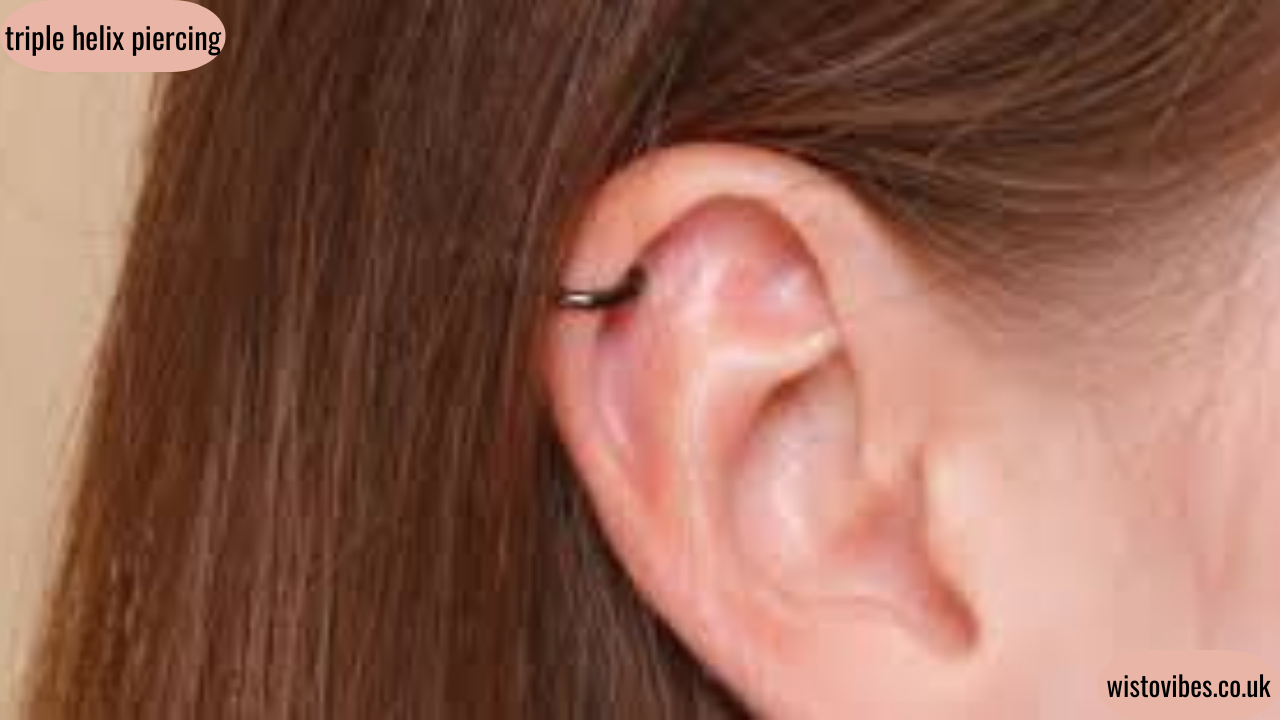A triple helix piercing is an eye-catching and stylish way to adorn the ear, providing a bold and unique look that has gained popularity in recent years. For those considering this piercing, or simply curious about its aesthetic appeal, this article offers an in-depth exploration of the procedure, aftercare, healing process, and potential risks. We’ll dive into the key aspects of the triple helix piercing, providing detailed insights to help you decide if it’s the right choice for you.
What is a Triple Helix Piercing?
A triple helix piercing refers to three piercings along the upper cartilage of the ear, often stacked vertically or placed in a specific pattern. The term “helix” refers to the outer rim of the ear, and getting a piercing in this area involves puncturing the cartilage. Unlike a single helix piercing, which consists of just one hole in the upper ear, the triple helix piercing offers a more dramatic look with multiple holes arranged in a line or a slightly curved design.
This piercing can be done symmetrically on both ears, or as a statement piece on just one ear, depending on the individual’s preference. The triple helix piercing is often paired with other ear piercings like the tragus or conch for a more extensive and layered ear jewelry look.
Why Choose a Triple Helix Piercing?
The appeal of a triple helix piercing lies in its bold and edgy look. For many, it serves as a way to express individuality and personal style. The piercing gives an ear a sleek, modern, and almost rebellious edge, often complementing other facial piercings. Another reason people opt for this piercing is the ability to customize the jewelry. From simple stud designs to ornate hoops or even diamond-encrusted options, the triple helix piercing provides ample room for creativity.
Additionally, because of its placement on the ear’s cartilage, the triple helix piercing can stand out prominently without obstructing other parts of the ear. This makes it a versatile option for anyone looking to add a bit of flair without overwhelming the entire ear.
How is the Triple Helix Piercing Done?
The triple helix piercing procedure is relatively simple but requires precision. It is generally performed by a professional piercer, as the ear’s cartilage is tougher than the softer tissue found in other parts of the body.
- Consultation and Design: The first step is a consultation with a piercer. During this consultation, the piercer will assess the shape of your ear and discuss your preferred placement of the three piercings. You may be asked about your jewelry preferences and the type of look you desire.
- Marking the Ear: The piercer will then mark the spots where the piercings will be placed, ensuring proper alignment and spacing.
- Piercing Process: Once you’re comfortable and ready, the piercer will use a sterile needle to puncture the cartilage. The piercing is done in quick succession to minimize discomfort. Depending on the specific design, the piercer may start with the top or the middle of the ear.
- Jewelry Insertion: After the piercings are made, the piercer will insert the chosen jewelry, usually a small stud or hoop. They may also provide you with initial jewelry that is slightly longer to accommodate swelling during the healing process.
The entire process typically takes about 15 to 30 minutes, and most individuals report only mild discomfort or pressure during the procedure.
Healing Process for a Triple Helix Piercing
As with any cartilage piercing, the healing time for a triple helix piercing is longer compared to earlobe piercings. Typically, it takes between 6 months to a year for a triple helix piercing to fully heal, although this varies depending on individual factors like aftercare and the body’s healing ability.
During the healing period, you may experience some swelling, redness, or tenderness around the pierced area. This is entirely normal, but any signs of excessive pain, pus, or infection should be addressed immediately by a healthcare provider.
Aftercare Tips for Your Triple Helix Piercing
Proper aftercare is crucial for a successful healing process. Here are some essential steps to follow:
- Clean the Piercings Regularly: Clean the pierced area twice a day with saline solution or a gentle piercing cleanser. Avoid using alcohol, hydrogen peroxide, or any harsh chemicals that can irritate the skin.
- Avoid Touching the Piercing: Minimize contact with your piercing, especially with unwashed hands, to prevent bacteria from entering the wound. If you must touch your piercing, make sure to wash your hands thoroughly beforehand.
- Be Careful with Sleeping: Since the triple helix piercing is located on the cartilage, it’s important to avoid putting pressure on the area while sleeping. Consider using a travel pillow or sleeping on the opposite side of your piercing to prevent discomfort.
- Avoid Swimming: During the healing period, it’s advised to avoid swimming in pools, hot tubs, or natural bodies of water, as these environments can introduce bacteria and delay the healing process.
- Monitor for Infection: Watch for signs of infection such as increased swelling, redness, or pus. If these symptoms occur, contact your piercer or a healthcare professional for guidance.
Pain and Sensitivity of a Triple Helix Piercing
Pain is subjective, but most people describe the sensation during the triple helix piercing procedure as a sharp pinch followed by a dull ache. The cartilage in the ear is more sensitive than the soft tissue of the earlobe, so there may be some discomfort, but it is generally brief.
After the piercing is complete, it is normal to experience some throbbing or sensitivity for a few days. This will subside as the healing process progresses, though some mild discomfort may persist for the first few weeks.
Risks and Considerations
While the triple helix piercing is generally safe when performed by a professional, there are a few risks to consider:
- Infection: Like all piercings, the risk of infection is present. Following proper aftercare instructions will help minimize this risk.
- Keloid Scarring: Some individuals are prone to developing keloids, which are raised scars that can form around the piercing site. If you have a history of keloid scarring, consult with your piercer beforehand.
- Rejection or Migration: In some cases, the body may attempt to reject the piercing, causing the jewelry to move or the piercing to close up. This is more common with cartilage piercings but can be avoided by following aftercare instructions carefully.
- Allergic Reactions: Some individuals may experience allergic reactions to certain metals used in piercing jewelry, such as nickel. Choosing hypoallergenic jewelry can help reduce this risk.
Jewelry Options for a Triple Helix Piercing
Choosing the right jewelry for your triple helix piercing is an important step in both the healing process and the aesthetic appeal. Initially, piercers will use larger jewelry to accommodate swelling. Once the piercing has healed, you can switch to smaller studs, hoops, or other designs.
Here are some common jewelry types for triple helix piercings:
- Studs: Simple and subtle, studs are a popular choice for those who want a classic, minimalistic look.
- Hoops: Hoops can create a more dynamic and bold appearance, especially if you opt for larger rings.
- Barbells: Curved or straight barbells are an alternative option for individuals who prefer a different style to studs or hoops.
Triple Helix Piercing Trends
The triple helix piercing continues to evolve, with new styles and combinations emerging. Many people enjoy pairing their triple helix piercing with other piercings like the forward helix, tragus, or conch for a more intricate and layered look. Jewelry styles, such as those with gemstones or custom-made designs, are also becoming more popular, adding personality and elegance to the piercing.
FAQs about Triple Helix Piercing
Q: Does a triple helix piercing hurt?
A: While the triple helix piercing may cause some discomfort due to the cartilage being pierced, the pain is generally brief and tolerable. The initial pinch is followed by a dull ache that subsides after a few days.
Q: How long does it take for a triple helix piercing to heal?
A: Healing time can vary, but it typically takes between 6 months to a year for the piercing to fully heal. The process may take longer if proper aftercare isn’t followed.
Q: Can I change the jewelry right after the piercing?
A: It’s best to wait until the piercing has fully healed before changing the jewelry. This typically takes several months, and doing so too early can cause irritation or infection.
Q: Are there any risks with a triple helix piercing?
A: Risks include infection, allergic reactions, keloid scarring, and piercing rejection. However, these can be minimized with proper aftercare and choosing a professional piercer.
Q: Can I wear other piercings with a triple helix?
A: Yes! Many people pair their triple helix piercing with other ear piercings, such as a tragus or conch, for a more layered, customized look.
Conclusion
A triple helix piercing is a stylish and bold way to express yourself through body modification. With its unique placement on the upper ear, it offers a chance to experiment with different jewelry and styles. However, it’s essential to follow proper aftercare instructions to ensure the healing process goes smoothly and minimize any risks. Whether you choose to have it done on one ear or both, a triple helix piercing is sure to make a statement and add a touch of elegance to your ear.




